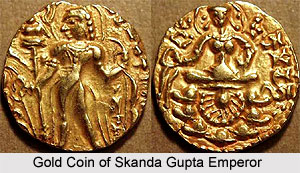 Skandagupta was the ruler of Northern India and is considered as the last of the great Gupta emperors. Skandagupta was the immediate successor of Kumaragupta I. The concluding years of Kumaragupta`s reign was full of troubles, due to the invasion of the Pushyamitras. Quite naturally Skandagupta faced some of the greatest challenges whilst contending with the Pushyamitras and the Hunas. Skandagupta ideally defeated the Pushyamitras. But soon after this he had to face the invading Indo-Hephthalites or `White Huns` from the northwest side. Scholars have opined that the successor of Kumaragupta I, Skandagupta did not find it an undisputed and peaceful succession to the throne of Gupta dynasty. According to them there was probably a civil war among the sons of Kumaragupta I in which Skandagupta ultimately emerged victorious. The Bhitari Pillar Inscription also corroborates the fact of civil war.
Skandagupta was the ruler of Northern India and is considered as the last of the great Gupta emperors. Skandagupta was the immediate successor of Kumaragupta I. The concluding years of Kumaragupta`s reign was full of troubles, due to the invasion of the Pushyamitras. Quite naturally Skandagupta faced some of the greatest challenges whilst contending with the Pushyamitras and the Hunas. Skandagupta ideally defeated the Pushyamitras. But soon after this he had to face the invading Indo-Hephthalites or `White Huns` from the northwest side. Scholars have opined that the successor of Kumaragupta I, Skandagupta did not find it an undisputed and peaceful succession to the throne of Gupta dynasty. According to them there was probably a civil war among the sons of Kumaragupta I in which Skandagupta ultimately emerged victorious. The Bhitari Pillar Inscription also corroborates the fact of civil war.
The theory of fratricidal struggle is vividly mentioned in the Bhitari pillar inscription. Through information about the contenders of the civil war, historians have opined that the most important competitor was the stepbrother of Skandagupta, Purugupta. He was the son of queen Anantadevi. The fact that Skandagupta had to cross swords with his stepbrother Purugupta is evident from the records of Bhitari pillar inscription. From the Bhitari pillar inscription it is known that Purugupta was the immediate successor of Kumaragupta. Historians have presumed that when Skandagupta was busy campaigning against the Pushyamitras, Purugupta took the advantage of Skandagupta`s absence and his father`s illness, in the process of usurping the throne. Hence no cordial relations existed between them. Kumaragupta II, grandson of Purugupta, also nurtured the hostility against Skandagupta. Hence there was a civil war between them, for the succession to the throne of Gupta dynasty. According to scholars since Skandagupta`s mother was not the chief queen of Kumaragupta, hence Skandagupta was not the legitimate aspirant of the throne. Therefore he had to take up sword in order to drive away the legitimate owner, Purugupta. A group of other historians also point out that Skandagupta was the most competent amongst all the princes. Therefore Kumaragupta chose him as his successor, which caused rivalry among the brothers, which ultimately resulted in the civil war.
Skandagupta died in 467 AD and was succeeded by his son Narasimha Gupta Baladitya, who was successful in ultimate driving of Huns from the land of India. In Javanese text Skandagupta`s name can be found as `Tantrikamandaka`. Chinese writer Wang-hieun-Tsang refers about Skandagupta and mentioned that an ambassador was sent to his court by king of Srilanka, Meghavarma. The more detailed account on Skandagupta can be got from the inscriptions in Allahabad pillar.



















